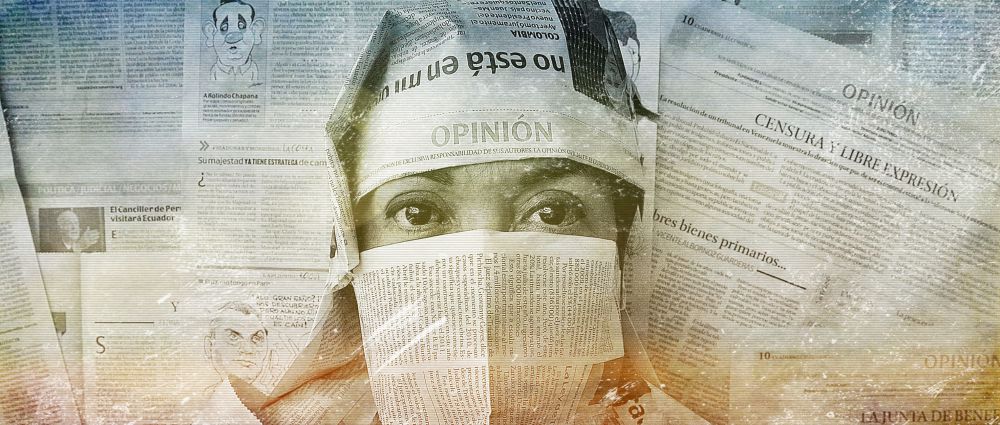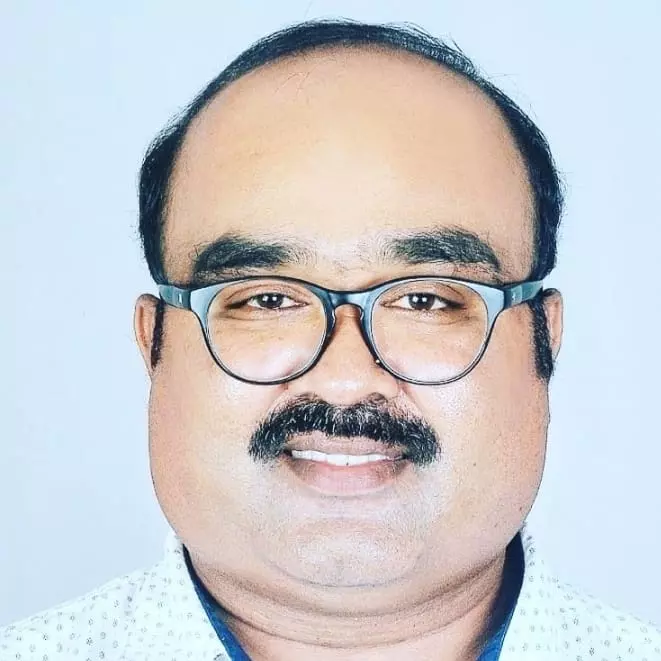

Defending free press is to defend the people’s sovereign power in a democracy. Credit: Ahdieh Ashrafi/Flickr CC 2.0
Media freedom under Modi regime
text_fieldsIndian capital and its suburban area have been witnessing an unprecedented surge of farmer's protest. The farmers demand that the government repeal the three Iaws that allow the safety, security and survival of the farmers at the mercy of monopoly capitalism. The three laws had been passed in parliament with the brutal majority of the ruling dispensations, but without sufficient discussion of democratic dimensions and or any other parliamentary mode of exchange of views, pros and cons. Millions of protesters are braving the freezing cold and corona pandemic in Delhi. The adverse conditions have already taken the toll; twenty two protesters have already succumbed to death. Many protesters are in the grip of many health issues, and their conditions are deteriorating day bay day. However, the Central government or the ultra jingoistic, rightist ideologues are still adamant and stubborn.
At a juncture like this, it is the role of the media to expose the ideology and the government as well as to strongly intervene in order to ensure justice for the country's breadwinners. Unfortunately, they play second fiddle to the official version of the bill, which is obviously anti- farmers and detrimental to food security of the nation and the farmer who toil in the earth and feed every Tom, Dick and Harry, layman, the mandarin, i.e, the country. The voice of the media is not vox populi, but a cacophony of yes men repeating the government version. The voice is His Masters Voice, logo of the HMV. These laws are favorable for the corporate like Ambani and Adani. The media are paying panegyrics to business magnates. It is quite natural; since most of the media are either owned or controlled by Ambani. The media indulge and utilize their full media muscle to praise Modi and deprecate the protesting farmers. The content of the media hype last week was the meeting of some farmers from Kutch district in Gujarat with the Prime Minister who alleviates the concerns of the farmers.
But the expose, appeared based on investigation by the hindi online portal Junputh and the english portal National Herald, prove that it was a just red herring to turn the attention of the protesting farmers. No single farmer from Delhi was there in the team who visited Modi. Actually, they were Sikh BJP workers. See how the drama unfurls. These Sikhs visited Modi seeking support for the Gurudwara in Lagpat in Kutch. They are never directly affected with agriculture issues or protest.
The leader of the group was Raju Bhai Sardar, BJP Secretary of Kutch region. He was presented farm leader on the visual media who get the clippings from NIA.
Any discourse or discussion on the media of Modi era cannot be started with the first premise of lack of morality of the media, and morality, impartial reporting without any prejudice are the cornerstones of media. The honesty that has been the tour de force of the media is now in shambles especially by NIA to sub serve the interest of the ruling dispensation. This is not a single incident. Now Aranab Goswami is in the center of the storm as media ethics is discussed. His whatsapp leakage manifests the subservient kowtowing attitude and its spread during the Modi era. What surprisingly comes in the open how fast the culture of subservience of mass media is spreading in the Modi era. Let us contrast with the fact many secular, impartial, staunch supporters of india's rich cultural diversity are loosing their jobs owing to the financial crisis and media houses are closing down. But one single TV channel is boasting, of the connection in the higher places and PMO, and of the access to strategically important national security information. Goswamy has no qualm to openly assert that he has huge influence on the Government to sway the decisions unfazing even the cabinet. Goswami is crystal clear subservience journalism epitome. The Janus like contradictory countenance of his is that he goes to any extreme rhetoric against the critics of state injustice, politicians, social workers and civil activists in his channel discussions.
Goswamy is more than a person, he is a movement. There are lot many of this sort in English and Hindi journalism who are hand in glove with the government and antagonistic toward those who raise gentle and democratic dissent against the government. They boast about immense influence on the government and on the judiciary to the extent that they can influence them. The access and the consequent information leakage these journals is not to satisfy an investigative journalistic mission. Goswamis wearing blazers and without it jostle to emulate Goebbels of Hitler. The discussions on the channels of these journalists do not show any democratic, but marked by holier than the attitude and imposing upper hands. Even the national security looks compromised in this unholy activity.
In fact, Goswami is not a disease. It is the classic and clinical system of the decay that has gripped the Indian media in the era of Modi. Indian media houses and journalists had been praised all over the world for its integrity and impartiality, but that very qualities are annihilated by Goswamis and crony journalists. Goswamis change themselves to swayamsevaks to metamorphose India into a monolithic religious state completely destroying its democratic structure, sole and credentials. They never like to questioned, instead they deprecate and belittle those who raise questions. The lesson they impart to media student is that of subservience. Both technology and crony capitalism are in league to satisfy the master.
Since 2014, when Modi came to power their prime intention was to gag freedom of journalism, and to destroy secular, diverse, and federal fabric of the country. No prime minister had such a dishonor. The nature of unleashing planned draconian control and interference on the media is far greater than the Emergency days. While objecting constructive criticism Modi is presenting himself as a selfless servant of the society. A holier culture of cult figure is imposed on the masses. He let unloose ED and other agencies any media house that does not fall in line or dance to his tunes. Advertisement is denied to the media that criticize the government. He repeatedly applies carrot and stick policies even on respected senior journalists. If this trick does not work he makes them exit ignominiously. Modism started in full bloom just before corona and lockdown hit the country. Before this, he contacted all the journalists and asked them to publish motivating and pro government news. But when loss of work and starvation death grabbed the news headline, the government lawyer/attorney general submitted in the Supreme Court that the court shall order journalists to publish government version. The independent and honest media houses did not get any consideration from the government during the coronian period.
Indian media is the most diversified in the world. Seventeen newspapers in different languages, more than one lakh weeklies and magazines, one hundred and seventy eight television channels and an uncountable number of online portals. In addition to this, a lot of youtube and facebook networks that claim to distribute news. While it is critics are criticized, gagged, and deprecate the democratic and secular journalists a plethora of yes men campaigners are in the midst of us. The most affected of all the women journalists who voice dissent. Unparliamentary verbal attach and threat of rape are used against them. Independent journalists are always branded as anti-nationals by the pro government media persons. Gauri Lankesh killed in Bangalore in 2017 is one of the victims this type of journalism. Even after her death she is not spared, one can see humiliations on the social media.
The direct threat in the Modi era is against criticism and critics. Unprecedented pressure is mounting over the media houses to sack the journalists who criticize the government. Now patriotism is Modi praise. Even the foreign journalists are not spared. Entry is denied to foreign journalists to North East and J&K. The Modi government is applying strict measures in foreign investment in the media sector. Huffington Post with its enviable role in journalism closed itself, thanks to the strict control of the government allowing only 24% of foreign investment. The Hindu, Hindustan Times, The Telegraph and many other journals find it difficult to withstand the onslaught. The number of sacked journalists in the last twelve months is unheard of.
What is strange about Modi is that he never interacts directly with the media. He is content and finding solace in monologues like Man Ki Bath. He does not encounter direct questions from the media.
The rise of social media users in India is phenomenal. It rose from 168 million 2016 to 326 million in 2018. The jingoistic rightist government utilize this situation to their ends. They find it facile and easy to make the people believe truths and half truths on the social media platform. Fake accounts and fake profile sow the seeds of distrust and animosity among the people. Paid employees to propagate Hindutva ideology on the social media is a reality now.
Punya Prasun Bajpai who was expelled from ABP news made it clear in an article written in The Wire that he was a victim of subservience and intolerance prevailing in many news rooms across the country. He says, he was directed not to criticize Modi while organizing programs. Two Hundred paid personnel are employed by the central government to instruct the editors and keep vigil over them ensuring Modi is not criticized. Bobby Ghosh of Hindustan Times resigned simply he had played leadership role to maintain a database of lynching and honour killings across the country. However, all is not dark. The wire, the scroll, the citizens, article 14, newsminute, altnews are some of the online media making bold steps. The telegraph and it's editor R.Rajagopal represent a rare moment and resistance, they are icons as history will record for a journalism of outright courageous criticism of modi. Though many journals are closing down, new journals are budding with staunch and devoted commitments to the ethics of journalism.
Reporters without border, an international organization on media freedom, published the index. India's position has slipped from 136 in 2014 to 148 in 2018, the year of Modi's second turn. We are behind Bangladesh, China and Sri Lanka in terms of media freedom. Fifty journalists, including Sidiq Kappan, are in jail on fabricated false charges.
Media freedom was part of Indian national struggle. Great stalwarts like Gandhi, Nehru and Ambedkar were journalists too. Indian media grew up in the lap of democratic dissent, debates and discussions. Media continued to voice against the government. Even the newspaper who kept their editorial blank as a form of protest on Emergency successfully survived the Emergency. We should compare the present crisis and abysmal fall of journalism of today with the yesteryears. It is obvious there are class and capital interests for any media house. But if freedom of press is denied then democracy is in peril. Autocracy has prevented always the right of the people to know. It was L K Advani who said about the media in Emergency that when asked to bow, the media prostrated. Subservient media and Goswamis are observing shayana pradakshina to Modi. The media houses may be oblivious of the romanticized ethics and a purity attributed to it. But there is one thing, which can never be compromised. When executive fails, when legislature fails, then man resorts to the media house. Protests and people's dissent are supported and persuaded by journalists. Every where autocrats are scared of freedom and free journalism. If we don't read the graffiti of times we are bound to fail to the extent that no would raise the voice for us.
(This article originally published in Madhyamam weekly was translated by Sibahathulla Sakib N)










